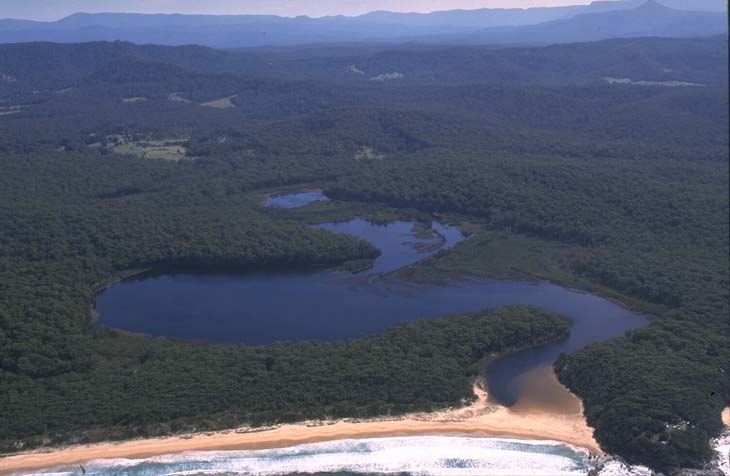Termeil Lake is located on the south coast of New South Wales between Ulladulla and Batemans Bay. It is classed as a back-dune lagoon with an intermittently closed entrance.
Termeil Lake is a near pristine estuary, tucked away within Meroo National Park.
Water quality report card
As part of our water quality monitoring program we assess the water quality and ecosystem health of an estuary using a range of relevant indicators. We sample a subset of the estuaries between Wollongong and the Victorian border every 3 years. The most recent sampling in Termeil Lake was completed over the 2020–21 summer, when 2 sites were sampled on a monthly basis.
This report card represents 2 water quality indicators that we routinely measure: the amount of algae present and water clarity. Low levels of these 2 indicators equate with good water quality.
Algae
Water clarity
Overall grade
The report card shows the condition of the estuary was excellent with:
- algae abundance graded good (B)
- water clarity graded excellent (A)
- overall estuary health graded excellent (A).
Grades for algae, water clarity and overall are represented as:
- A – excellent
- B – good
- C – fair
- D – poor
- E – very poor.
Go to estuary report cards to find out what each grade means, read our sampling, data analysis and reporting protocols, and find out how we calculate these grades.
We have monitored water quality in Termeil Lake since 2008. This table shows the water quality grades for this estuary over that time.
| Year | Algae | Water clarity | Overall grade |
|---|---|---|---|
| 2007–08 | D | B | C |
| 2009–10 | B | C | B |
| 2010–11 | A | B | A |
| 2011–12 | B | B | B |
| 2012–13 | A | D | C |
| 2013–14 | B | A | B |
| 2014–15 | B | C | C |
| 2015–16 | A | C | B |
| 2016–17 | C | E | D |
| 2017–18 | A | B | B |
| 2019–20 | D | A | C |
Physical characteristics
| Estuary type | Back-dune lagoon |
|---|---|
| Latitude (ºS) | –35.46 |
| Longitude (ºE) | 150.39 |
| Catchment area (km2) | 14 |
| Estuary area (km2) | 0.6 |
| Estuary volume (ML) | 397.9 |
| Average depth (m) | 0.7 |
Tidal exchange volume
Tidal exchange volume or tidal prism data is available for this estuary. This tidal prism was measured in 2001.
| Tide state | Flow (ML) | Local tidal range (m) | Sydney Harbour tidal range (m) |
|---|---|---|---|
| Ebb flow | 390 | 0.54 | 1.22 |
| Flood flow | 300 | 0.49 | 1.24 |
Notes: km2 = square kilometres; m = metres; m3 = cubic metres; ML = megalitres.
Water depth and survey data
Bathymetric and coastal topography data for this estuary are available in our data portal.
Land use
The catchment of Termeil Lake is moderately disturbed, with about one-third of land use changed to grazing and rural residential development. Most of the catchment remains as forest within Meroo National Park and Forestry Corporation land.
National and marine parks
- Termeil Lake is situated within Meroo National Park.
- This estuary does not flow into a marine park.
Citizen science projects
- The South Coast Shorebird Recovery Program provides the opportunity for people to get involved in the protection and recovery of shore birds.
- The Budawang Coast Nature Map is an online data platform the community can use to record and identify biodiversity. Data collected is used to map the distribution of native plant and animal species from Moruya up almost to Kiama.
Community involvement
- The Shoalhaven Landcare Association represents a range of volunteer groups working in and around the Termeil Lake catchment.

Aerial view of Termeil Lake estuary.
Local government management
Local councils manage estuaries within their area unless the estuary is attached to a marine park. Shoalhaven City Council manages this estuary.
Threatened species
The catchment around Termeil Lake supports the Bangalay Sand Forest of the Sydney Basin and South East Corner bioregions, an endangered ecological community.
Read more about the biodiversity in our estuaries.